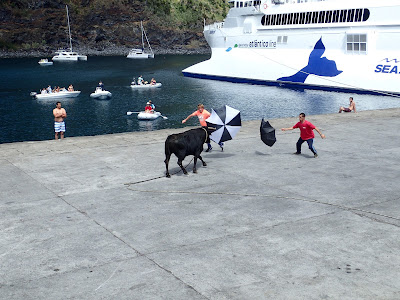Really it's more like bull baiting or teasing with a lot of running (men) then fighting. The Azoreans love their bullfights and proudly proclaim they do not harm the beasts but instead admire them, even revere them. There is not supposed to be any blood. Four strong young men hold onto to the bull via a leash which they whip up and down to get the bull riled while other men, young and old, run in front of the bull. The brave ones try to outstare the bull as it looks at them and then run around in tighter and tighter circles with his hand on the bulls forehead or close to it. The bull can't manage the tight curves and eventually gives up, hopefully before the guy. The brave but not so brave ones, yell or whistle at the bull and then take off in the opposite direction to climb a wall, hide between houses or jump into the water depending on the venue. All watching clap, jeer and/or drink as the entertainment requires.
We saw two bullfights - one in San Jorge on the sea's edge and the other in Angra do Heroismo in the middle of the city. Although glad to be part of the audience, twice was enough. It was fun to see the tradition and the enthusiasm of both the crowd and the bull fighters - not so much the bull who always looked a bit dazed and relieved to be shut back into his crate after the production.
 |
| In Sao Jorge, the young and inexperienced men waited for the bull, ready in bathing suits to dive into the water as the bull almost sauntered by with a occasional thrust of his horns. Braver than I but...compared to their elders, they had a lot to learn. |
 |
| The guys with the black hats controlled the beast, running after or perhaps being pulled after the bull when on the move and trying to vex him with the leash when he paused for breath. They appropriately climbed the walls if the bull made an about face and started towards them. |
 |
| This was an older man, dressed in red, who teased and then leapt but only at the last minute. He'd done it before and obviously enjoyed the thrill. |
 |
| Several of the men had umbrellas they used as the stereotypical red cloak. They would twirl the brallie, hold it slightly to the side and when the bull charged.... |
 |
| pull it away. Poor, frustrated bull! |
 |
| And again, and again, and again... |
 |
| A little bit of teasing to get the bull antsy. |
 |
| And here's the very brave, doing tight circles, while looking behind him. Yikes! He really shouldn't trip! |
 |
| This show all took place in the port on a Sunday. The port was closed but the staff had been busy all day arranging the containers into bleachers with forklifts. At first we sat in the first row, legs dangling but bulls don't leap so we felt safe. Then we moved to TomTom to watch from the water with many other boats. |
 |
| New bull, same antics. Between bulls there was lots of beer served to both audience and the guys in the "ring". As the men became more lubricated they, of course, became braver. |
 |
| In Angra do Herismo, the four bulls arrived in crates totally encased. We stood on a private patio overlooking the street which was jammed with others watching, men strutting their mojo, guys hawking snacks and drinks (we had a great caipirinha). Lots to look at, tons of fun and a true cultural event. |
 |
| And the bull is released, dazed and not too happy. Felt sorry for him :( |
 |
| The senors at work. They ran down the street at full speed after the bull and then 45 sec later were back following the bull who, I guess, was lost. |
 |
| This guy seemed a bit nonplussed. Not really into it. |
 |
| Another part of the tradition, which the women were part of, was to hang colourful, handmade blankets over their balconies. These were all along the street and certainly added to the ambience. The women were smart to show off their prowess from the safety of their balconies while the men were on the street with the bull. |
We left quickly down the bull fighting street between bulls, having had our fill. This bull had been hurt - big pools of blood were splashed on the street. He was definitely relieved to get back in his crate.
These bull fights seem to occur almost every day somewhere in Terceira and on the other islands, perhaps less frequently. I'm sure it's a tourist event but the people we saw in the audience and on the street were locals. It's a tradition that is carried on with enthusiasm. Really fun to see - but I wouldn't want to be the bull.
















No comments:
Post a Comment